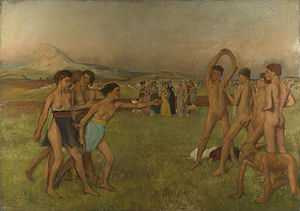Young Spartans Exercising
 | |
| Artist | Edgar Degas |
|---|---|
| Year | about 1860 |
| Type | Oil on canvas |
| Dimensions | 109.5 cm × 155 cm (43.1 in × 61 in) |
| Location | The National Gallery, London |
Young Spartans Exercising, also known as Young Spartans and also as Young Spartan Girls Challenging Boys,[1] is an oil on canvas painting by French impressionist artist Edgar Degas. The work depicts two groups of male and female Spartan youths exercising, though the subject matter of the painting has, in recent times, been challenged. The work is now in the permanent collection of The National Gallery in London.
Depiction
The painting depicts as its subject matter two groups of youths, four women and five men, with the young women apparently taunting or beckoning the men. The women are positioned to the left of the painting, the men to the right, while in-between the two groups in the background appear a third group watching the youths; their appearance striking as they are fully dressed while the youths in the foreground stand naked or topless. Behind the onlookers, identified as Lycurgus and the youths' mothers,[2] lies the city of Sparta, dominated by Mount Taygetus, from which the bodies of the society's "unfit" children were supposedly thrown into a ravine, to die from trauma or exposure.
History
The painting was begun in 1860 with Degas returning to the canvas to rework the piece over the following years, though it remained unfinished upon the artist's death. X-rays taken of the work during the early 21st century have revealed that Degas changed the positioning of the youths, their faces, and even their number; this last change resulted in the strange image of the four women in the foreground having ten legs among them.[3] Degas' revisitation of the faces of the youths is often mentioned in art criticism, as it is believed the artist changed the features of the youths from the classic handsome Greek ideal, to a more urban modernistic look. The French art historian André Lemoisne, was first to note on this fact, remarking that the subjects had a contemporary Parisian look, more akin to the "gamins of Montmartre".[2] More recent critics agree with Lemoisne, believing Degas was attempting to "update" his painting.[2]

A second full-scale version of the painting exists, held by the Art Institute of Chicago. This version is much less finished, but it shows a vastly different background, with a more detailed landscape and a large architectural structure, around which the characters in the background are resting.[3] The work also shows how Degas changed the number of foreground figures with an additional boy on the right of the painting.
Young Spartans Exercising was purchased by the National Gallery in 1924 and, as of late 2013, is displayed in Room 41.[4]
Criticism
In 1879, Italian art critic Diego Martelli, described the unfinished work as "one of the most classicizing paintings imaginable"; though after Martelli's remarks, Degas returned to the painting removing the classicizing architecture.[2]
In a 1985 edition of The Art Bulletin, art critic Carol Salus hypothesises that the work "... has traditionally been interpreted as representing young women challenging young men to wrestle or race, is instead a presentation of Spartan courtship rites".[5] This position was challenged in the same publication the following year, with Linda Nochlin arguing that the work could encompass a variety of meanings,[5] and by referring to Degas' own reluctance to explain the work in any great detail, allows the viewer to interpret the work to their own merit. This view is echoed by Christopher Riopelle, curator of 19th-century painting at the National Gallery, who in 2004 stated that the painting, "...starts as a traditional historical painting, closely based on classical accounts and meticulous research. It ends as something much more enigmatic."[3]
References
- ↑ "Degas and the Nude". Monographic exhibition in Paris at the Musée d'Orsay, 13 March - 1 July 2012. Retrieved April 2015.
- ↑ 2.0 2.1 2.2 2.3 Martha Lucy (2009). "Reading the Animal in Degas's Young Spartans". 19th Century Art Worldwide. Retrieved 12 May 2010.
- ↑ 3.0 3.1 3.2 Maev Kennedy (25 October 2004). "How Degas reworked a classic image". The Guardian. Retrieved 12 May 2010.
- ↑ "Young Spartans Exercising". The National Gallery. Retrieved 12 May 2010.
- ↑ 5.0 5.1 Carol Salus (September 1986). "Degas' Young Spartans Exercising, The Art Bulletin". JSTOR 3050983.
External links
- Degas: The Artist's Mind, exhibition catalog from The Metropolitan Museum of Art fully available online as PDF, which contains material on Young Spartans Exercising (see index)
| ||||||||||||||